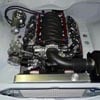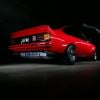OK so I've been working on a power steering conversion (more on that later) which has brought me to an interesting discovery. I've read most of the suspension and steering stuff on this site and I'm pretty sure I haven't seen any mention of this?
I have a UC cross member with a second set of holes drilled for the upper control arms, approx 25mm lower in the LX RTS position. I have a UC steering rack, and an LX RTS steering rack.
It occurred to me as I was taking various measurements that lowering the upper control arm actually changes the axis of the inner suspension pivots quite significantly. It was immediately obvious that this could affect bump steer (mainly because that's what I was measuring for to start with!) - check out the different in the string lines, and the horizontal difference at rack height:

(please ignore the crap in the garage, I'm a messy worker...)
Now you'll also notice in the pic above that I have two different length racks - the one bolted up being UC and the bare one sitting on top being LX RTS. There is approx 15mm difference in overall length (~7.5mm per side, LX 620mm and UC 635mm) which appears to correspond with the difference in the suspension axis:

From what I can measure on the housings, there is no difference in the height of the rack mounting position between the two, and the housings are externally the same. However, the LX housing does have more depth machined into the ends of it so that the rack gets similar travel to the UC one (so the steering lock between the two should be much the same despite the length difference). I don't see any reason why the UC rack couldn't go into the LX housing but you'd lose lock/travel if you didn't machine the inner ends.
Clearly there is an effect on bump steer and I would assume that Holden had some idea of what they were doing, so it seems that you would be best using a UC rack with the upper control arm mounted in the top position, and the LX rack with it in the lower position.
I haven't take enough measurements (not to great enough accuracy anyway) to calculate the bump steer properly and confirm the last statement, I think I will have to now (I will measure it directly when I get to the new rack). Some quick calcs give me around 0.2mm difference. Of course it needs to be stated for the record that the different steering arms also play a part (probably a larger part). Also I am aware that pre-RTS LH/early LX had slightly different upper arm mounting points again, I don't have access to any steering racks or measurements from these earlier cars to see whether they are different again.




 View Garage
View Garage












